-

 Fire damaged but still robustly intact cast iron Capel St street sign .This pieced of Dublin history was acquired in the UK where the story goes a former British soldier brought it home as a souvenir after extracting it from the post 1916 Easter rising burning rubble.Whether this anecdote is true or not, we feel this is a unique and once off item not to be missed ! For further information on pricing and shipping costs please contact us directly at irishpubemporium@gmail.com 60cm x 14cm 5kg It is sometimes claimed that the street takes its name from the chapel of St Mary's Abbey; other Capel Streets may be named after chapels, but this one is named after Arthur Capell, 1st Earl of Essex, Lord Lieutenant of Ireland 1672–1677. Built by Sir Humphrey Jervis in the late 17th century, he also built Essex Bridge (today Grattan Bridge), and the street was known for its mansions and a royal mint. In the 18th century, it became a commercial hub, with two-bay buildings replacing the "Dutch Billy" houses.The Capel Street Theatre also stood there in the 18th century. The Torch Theatre operated on Capel Street in 1935–41. The street declined in the 20th century, before a revival around the 1980s. Today it is known for its variety of restaurants, shops, cafés and pubs; as Panti, the owner of Pantibar put it, "You can buy a lightbulb, sexual lubricant, Brazilian rice, get a pint and go to a trad session." Louis Copeland's tailor is another notable business.
Fire damaged but still robustly intact cast iron Capel St street sign .This pieced of Dublin history was acquired in the UK where the story goes a former British soldier brought it home as a souvenir after extracting it from the post 1916 Easter rising burning rubble.Whether this anecdote is true or not, we feel this is a unique and once off item not to be missed ! For further information on pricing and shipping costs please contact us directly at irishpubemporium@gmail.com 60cm x 14cm 5kg It is sometimes claimed that the street takes its name from the chapel of St Mary's Abbey; other Capel Streets may be named after chapels, but this one is named after Arthur Capell, 1st Earl of Essex, Lord Lieutenant of Ireland 1672–1677. Built by Sir Humphrey Jervis in the late 17th century, he also built Essex Bridge (today Grattan Bridge), and the street was known for its mansions and a royal mint. In the 18th century, it became a commercial hub, with two-bay buildings replacing the "Dutch Billy" houses.The Capel Street Theatre also stood there in the 18th century. The Torch Theatre operated on Capel Street in 1935–41. The street declined in the 20th century, before a revival around the 1980s. Today it is known for its variety of restaurants, shops, cafés and pubs; as Panti, the owner of Pantibar put it, "You can buy a lightbulb, sexual lubricant, Brazilian rice, get a pint and go to a trad session." Louis Copeland's tailor is another notable business. -
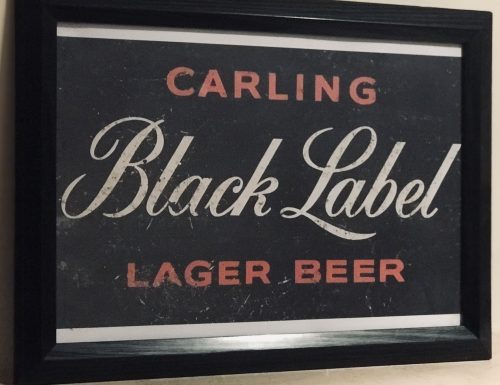 Carling Black Label Beer Retro advert fashioned from the blood, sweat,tears and spillage of a well used Irish Bar Tray & enamel advertising signs.Using high quality reprographics we have brought every scratch,dent and mark back to life in the shape of this unique series of prints. Dimensions :35cm x 48cm Glazed Even though Carling originated in Canada,it’s popularity spread widely throughout the Commonwealth including Ireland .A famous advertising campaign “I bet he drinks Carling” contributed hugely to the brands market share . Carling Black Label is a Canadian brand of lagerdistributed by Carling Brewing Company. In several countries, it is also known as Carling Black Label, and in Sweden, it is known as Carling Premier. In the United Kingdom it is now known as just Carling.
Carling Black Label Beer Retro advert fashioned from the blood, sweat,tears and spillage of a well used Irish Bar Tray & enamel advertising signs.Using high quality reprographics we have brought every scratch,dent and mark back to life in the shape of this unique series of prints. Dimensions :35cm x 48cm Glazed Even though Carling originated in Canada,it’s popularity spread widely throughout the Commonwealth including Ireland .A famous advertising campaign “I bet he drinks Carling” contributed hugely to the brands market share . Carling Black Label is a Canadian brand of lagerdistributed by Carling Brewing Company. In several countries, it is also known as Carling Black Label, and in Sweden, it is known as Carling Premier. In the United Kingdom it is now known as just Carling.History
Although its original focus was on ale, Carling has been brewing lager-style beers since the 1870s. In 1927, as part of an overall corporate re-branding effort under new president J. Innes Carling, the company renamed its already popular Black & White Lager to Black Label. Three years later, Carling was purchased by Toronto business tycoon E. P. Taylor, who merged the company into his Canadian Breweries Limited (CBL), which grew to be the world's largest brewing company, at least for a time. Under Taylor, Black Label was promoted as CBL's flagship brand and went on to become the world's first beer to be brewed on a mass international scale,becoming particularly popular in Commonwealth countries such as the United Kingdom, Australia, New Zealand and South Africa.Canada
In response to a shift in popular taste away from ale, Carling added a three-storey lager plant to their main London, Ontario, brewery in 1877. Carling's Lager (later renamed Carling's Bavarian Stock Lager, and then Carling's Imperial Club Lager) was the company's first lager brand. Carling's Black & White Lager was introduced in the 1920s and later renamed Black Label Lager, in contrast to their recently launched Red Cap Ale. Due to its strength and price, the brand quickly became popular with the country's working class, perhaps most famously among the loggers and miners of Northern Ontario, where the brand gained a tough, blue-collar image. Around 1990, Black Label had an advertising campaign in Canada, which used the phrase "The Legend is Black."United States
After the repeal of prohibition in 1933, the Peerless Motor Car Company, looking for a way to diversify in the poor car market of the depression, purchased the American rights to Carling's formulas, identifying labels, and trademarks. Technicians and brewmasters were sent from Canada to convert a Peerless plant in Cleveland, Ohio, into the Brewing Corporation of America. They first tried just brewing Carling's Red Cap Ale, but sales were too slow to maintain the brewery, and sales didn't climb until the introduction of Black Label lager. The philosophy behind Black Label was to have a high quality lager that was available nationwide but with a locally brewed budget price. The strategy worked, and the next several decades led to rapid growth and expansion for the brewery and the Carling Black Label brand. When Carling stopped producing Black Label to focus on a more profitable lager, they found their sales plummeting. Carling re-introduced Black Label with a beautiful blonde named Mabel, portrayed by Jeanne Goodspeed, with the slogan "Hey Mabel, Black Label!". The twenty-year marketing campaign cemented the name in the popular culture of America. In 1979, after several years of intense pressure from the larger American Brewers Miller and Anheuser-Busch, Carling-National was bought out by the Heileman Brewing Co. of La Crosse, Wisconsin. Carling and the Black Label brand are currently owned by the Molson Coors Brewing Company. Though no longer widely distributed in the U.S., Black Label remains the official beer of Beer Frisbee.United Kingdom
Black Label was introduced to the United Kingdom in 1952. Originally, it was only available in bottles, but in 1965, The Hill Top in Sheffield became the first pub to pour Carling Black Label draughts.In the 1970s and 80s, Carling Black Label sales were driven to great heights, due partly to increased advertising support, in particular the classic "I bet he drinks" series of advertisements, and partly with the launch of Carling Black Label in cans. Cans were important to Carling's success as they helped open up the "take home" market.[3] The "I bet he drinks" series of ads showed someone doing something cool, clever or difficult, and having a bystander say "I bet he drinks Carling Black Label". With the help of this advertising campaign, it became Britain's best-selling brand of beer in 1971. In the 1980s, many of the adverts featured comedians Mark Arden and Stephen Frost, also known as The Oblivion Boys, delivering the classic punchline. One of the advertisements in the series, Dambusters from 1989, was a parody of the 1955 film of the same name, and was ranked at number 12 on ITV's list of the "Best Ever Ads" in 2005, and at number 17 on Channel 4's list of the "100 Greatest TV Ads" in 2000.Campaign Live also ranked it at number 5 in their list of the "Top 10 Funniest TV Ads of All Time" in 2008. Carling has remained Britain's best selling beer since 1985. 'Black Label' has been dropped from the brand name and logo in Britain since 1997. Carling Black Label sign on a club in Pontefract, West Yorkshire.
Carling Black Label sign on a club in Pontefract, West Yorkshire.South Africa
In South Africa, Black Label began to take on a different tone with the anti-apartheid movement. This was partly due to the fact that, at 5.5%, it had more alcohol than the other brands of beer that generally had 5.0%, as noted in the popular advertising catch phrase "only hard working students deserve an extra 0.5 percent."Furthermore, the connotation of black to the racial issue became a point of pride to the native Africans. It used to be sold with the motto, "America's Lusty, Lively Beer", perhaps in reference to Canada, though it is seldom seen in the United States. The motto came from an older advertising campaign in the United States. Another famous Afrikaans slogan for Black Label in South Africa is, "Black Label sê die bybel", which means "The Bible says (one should drink) Black Label." SABMiller variants of Black Label
SABMiller variants of Black Label -

 Nice Carling Black Label Mirror 50cm x 42cm Sneem Co Kerry Even though Carling originated in Canada,it’s popularity spread widely throughout the Commonwealth including Ireland .A famous advertising campaign “I bet he drinks Carling” contributed hugely to the brands market share . Carling Black Label is a Canadian brand of lagerdistributed by Carling Brewing Company. In several countries, it is also known as Carling Black Label, and in Sweden, it is known as Carling Premier. In the United Kingdom it is now known as just Carling.
Nice Carling Black Label Mirror 50cm x 42cm Sneem Co Kerry Even though Carling originated in Canada,it’s popularity spread widely throughout the Commonwealth including Ireland .A famous advertising campaign “I bet he drinks Carling” contributed hugely to the brands market share . Carling Black Label is a Canadian brand of lagerdistributed by Carling Brewing Company. In several countries, it is also known as Carling Black Label, and in Sweden, it is known as Carling Premier. In the United Kingdom it is now known as just Carling.History
Although its original focus was on ale, Carling has been brewing lager-style beers since the 1870s. In 1927, as part of an overall corporate re-branding effort under new president J. Innes Carling, the company renamed its already popular Black & White Lager to Black Label. Three years later, Carling was purchased by Toronto business tycoon E. P. Taylor, who merged the company into his Canadian Breweries Limited (CBL), which grew to be the world's largest brewing company, at least for a time. Under Taylor, Black Label was promoted as CBL's flagship brand and went on to become the world's first beer to be brewed on a mass international scale,becoming particularly popular in Commonwealth countries such as the United Kingdom, Australia, New Zealand and South Africa.Canada
In response to a shift in popular taste away from ale, Carling added a three-storey lager plant to their main London, Ontario, brewery in 1877. Carling's Lager (later renamed Carling's Bavarian Stock Lager, and then Carling's Imperial Club Lager) was the company's first lager brand. Carling's Black & White Lager was introduced in the 1920s and later renamed Black Label Lager, in contrast to their recently launched Red Cap Ale. Due to its strength and price, the brand quickly became popular with the country's working class, perhaps most famously among the loggers and miners of Northern Ontario, where the brand gained a tough, blue-collar image. Around 1990, Black Label had an advertising campaign in Canada, which used the phrase "The Legend is Black."United States
After the repeal of prohibition in 1933, the Peerless Motor Car Company, looking for a way to diversify in the poor car market of the depression, purchased the American rights to Carling's formulas, identifying labels, and trademarks. Technicians and brewmasters were sent from Canada to convert a Peerless plant in Cleveland, Ohio, into the Brewing Corporation of America. They first tried just brewing Carling's Red Cap Ale, but sales were too slow to maintain the brewery, and sales didn't climb until the introduction of Black Label lager. The philosophy behind Black Label was to have a high quality lager that was available nationwide but with a locally brewed budget price. The strategy worked, and the next several decades led to rapid growth and expansion for the brewery and the Carling Black Label brand. When Carling stopped producing Black Label to focus on a more profitable lager, they found their sales plummeting. Carling re-introduced Black Label with a beautiful blonde named Mabel, portrayed by Jeanne Goodspeed, with the slogan "Hey Mabel, Black Label!". The twenty-year marketing campaign cemented the name in the popular culture of America. In 1979, after several years of intense pressure from the larger American Brewers Miller and Anheuser-Busch, Carling-National was bought out by the Heileman Brewing Co. of La Crosse, Wisconsin. Carling and the Black Label brand are currently owned by the Molson Coors Brewing Company. Though no longer widely distributed in the U.S., Black Label remains the official beer of Beer Frisbee.United Kingdom
Black Label was introduced to the United Kingdom in 1952. Originally, it was only available in bottles, but in 1965, The Hill Top in Sheffield became the first pub to pour Carling Black Label draughts.In the 1970s and 80s, Carling Black Label sales were driven to great heights, due partly to increased advertising support, in particular the classic "I bet he drinks" series of advertisements, and partly with the launch of Carling Black Label in cans. Cans were important to Carling's success as they helped open up the "take home" market.[3] The "I bet he drinks" series of ads showed someone doing something cool, clever or difficult, and having a bystander say "I bet he drinks Carling Black Label". With the help of this advertising campaign, it became Britain's best-selling brand of beer in 1971. In the 1980s, many of the adverts featured comedians Mark Arden and Stephen Frost, also known as The Oblivion Boys, delivering the classic punchline. One of the advertisements in the series, Dambusters from 1989, was a parody of the 1955 film of the same name, and was ranked at number 12 on ITV's list of the "Best Ever Ads" in 2005, and at number 17 on Channel 4's list of the "100 Greatest TV Ads" in 2000.Campaign Live also ranked it at number 5 in their list of the "Top 10 Funniest TV Ads of All Time" in 2008. Carling has remained Britain's best selling beer since 1985. 'Black Label' has been dropped from the brand name and logo in Britain since 1997. Carling Black Label sign on a club in Pontefract, West Yorkshire.
Carling Black Label sign on a club in Pontefract, West Yorkshire.South Africa
In South Africa, Black Label began to take on a different tone with the anti-apartheid movement. This was partly due to the fact that, at 5.5%, it had more alcohol than the other brands of beer that generally had 5.0%, as noted in the popular advertising catch phrase "only hard working students deserve an extra 0.5 percent."Furthermore, the connotation of black to the racial issue became a point of pride to the native Africans. It used to be sold with the motto, "America's Lusty, Lively Beer", perhaps in reference to Canada, though it is seldom seen in the United States. The motto came from an older advertising campaign in the United States. Another famous Afrikaans slogan for Black Label in South Africa is, "Black Label sê die bybel", which means "The Bible says (one should drink) Black Label." SABMiller variants of Black Label
SABMiller variants of Black Label -
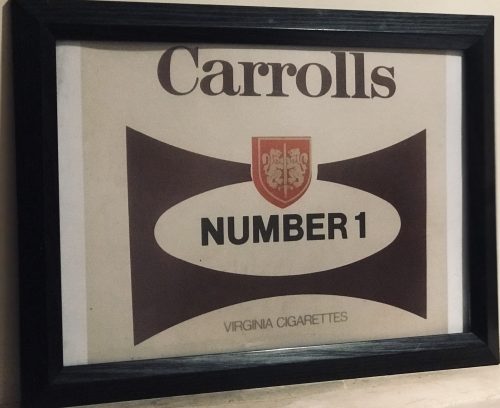 Carrolls Number 1 Virginia Cigarettes Retro advert fashioned from the blood, sweat,tears and spillage of a well used Irish Bar Trays & enamel signs.Using high quality reprographics we have brought every scratch,dent and mark back to life in the shape of this unique series of prints. Dimensions : 35cm x 48cm GlazedP. J. Carroll & Company Limited, often called Carroll's, is a tobacco company in Republic of Ireland. It is Ireland's oldest tobacco manufacturer and is now a subsidiary of British American Tobacco Plc.Its cigarette brands were among the best selling in Ireland in the twentieth century. Its factory was for decades the largest employer in Dundalk. Patrick James Carroll (b. 1803) completed his apprenticeship as a tobacconist in 1824 and opened a shop in Dundalk, later also manufacturing cigars.Patrick James moved to Liverpool in the 1850s. His son Vincent Stannus Carroll expanded the firm in the later 19th century.His son James Marmion Carroll moved to a house outside Dundalk.A second factory was opened, in Liverpool, in 1923. The company went public in 1934. A purpose-built factory opened in 1970. Designed by Ronnie Tallon of Michael Scott and Partners, it was described by Frank McDonald as "way ahead of anything else in Ireland at the time". In 1974 to mark the 150th anniversary of its founding, P.J. Carroll published an illustrated booklet by the writer James Plunkett: P. J. Carroll & Co. Ltd, Dublin & Dundalk - A Retrospect, outlining the development of the company in its historical context. Carroll's was acquired by Rothmans in 1990; Rothmans was acquired by British American Tobacco Plc in 1998. The company's share of the Irish tobacco market is around 17%. In 2002 the Dundalk site was sold for €16.4m to the Department of Education and repurposed for the campus of Dundalk Institute of Technology. Carroll's rented back a small section for its remaining factory operations, until finally ceasing its Dundalk operations in 2008. Carrolls remains an Irish company with deep connections to hundreds of retirees and nearly 40 staff based in their Dublin offices. PJ Carroll agrees that the Government should regulate on smoking and health issues; this regulation should be informed, evidence-based, and proportionate. PJ Carroll and BAT acknowledge that smoking is a cause of various serious and fatal diseases, including lung cancer, emphysema, chronic bronchitis and cardiovascular diseases. In 2013,some lawmakers suggested PJ Carroll should be prohibited from speaking with lawmakers on the basis of the WHO Framework Convention on Tobacco Control (FCTC). PJ Carroll comes under the definition of Tobacco Industry as set out by the FCTC, but the FCTC does not prohibit engagement between tobacco companies and public representatives, but puts in place strict rules relating to transparency.
Carrolls Number 1 Virginia Cigarettes Retro advert fashioned from the blood, sweat,tears and spillage of a well used Irish Bar Trays & enamel signs.Using high quality reprographics we have brought every scratch,dent and mark back to life in the shape of this unique series of prints. Dimensions : 35cm x 48cm GlazedP. J. Carroll & Company Limited, often called Carroll's, is a tobacco company in Republic of Ireland. It is Ireland's oldest tobacco manufacturer and is now a subsidiary of British American Tobacco Plc.Its cigarette brands were among the best selling in Ireland in the twentieth century. Its factory was for decades the largest employer in Dundalk. Patrick James Carroll (b. 1803) completed his apprenticeship as a tobacconist in 1824 and opened a shop in Dundalk, later also manufacturing cigars.Patrick James moved to Liverpool in the 1850s. His son Vincent Stannus Carroll expanded the firm in the later 19th century.His son James Marmion Carroll moved to a house outside Dundalk.A second factory was opened, in Liverpool, in 1923. The company went public in 1934. A purpose-built factory opened in 1970. Designed by Ronnie Tallon of Michael Scott and Partners, it was described by Frank McDonald as "way ahead of anything else in Ireland at the time". In 1974 to mark the 150th anniversary of its founding, P.J. Carroll published an illustrated booklet by the writer James Plunkett: P. J. Carroll & Co. Ltd, Dublin & Dundalk - A Retrospect, outlining the development of the company in its historical context. Carroll's was acquired by Rothmans in 1990; Rothmans was acquired by British American Tobacco Plc in 1998. The company's share of the Irish tobacco market is around 17%. In 2002 the Dundalk site was sold for €16.4m to the Department of Education and repurposed for the campus of Dundalk Institute of Technology. Carroll's rented back a small section for its remaining factory operations, until finally ceasing its Dundalk operations in 2008. Carrolls remains an Irish company with deep connections to hundreds of retirees and nearly 40 staff based in their Dublin offices. PJ Carroll agrees that the Government should regulate on smoking and health issues; this regulation should be informed, evidence-based, and proportionate. PJ Carroll and BAT acknowledge that smoking is a cause of various serious and fatal diseases, including lung cancer, emphysema, chronic bronchitis and cardiovascular diseases. In 2013,some lawmakers suggested PJ Carroll should be prohibited from speaking with lawmakers on the basis of the WHO Framework Convention on Tobacco Control (FCTC). PJ Carroll comes under the definition of Tobacco Industry as set out by the FCTC, but the FCTC does not prohibit engagement between tobacco companies and public representatives, but puts in place strict rules relating to transparency.Brands
- "Carrolls Number 1", its first filter cigarette, was launched in 1958.
- "Carrolls Additive Free* Red" and "Carrolls Additive Free* Blue" was launched in 2013 as additive free* cigarettes started to gain popularity across Western Europe. (*No additives in the tobacco blend does NOT mean a less harmful cigarette)
- "Pall Mall" is one of PJ Carroll's strongest growing brands.
- Vogue is PJ Carroll's premium cigarette brand.
- "Major",[4] a full flavor cigarette.
- "Sweet Afton", launched in 1919, was named after "'Afton Waters" by Robert Burns, whose sister Agnes was buried in a graveyard opposite the old Carrolls factory in Church Street, Dundalk.[2]Sweet Afton cigarettes were discontinued in the Autumn of 2011.
Sponsorship[edit]
Carroll's was a major sponsor of sport in Ireland until restrictions were imposed on tobacco advertising. The company had naming rights over the GAA All Stars Awards (1971–78);[8] and Irish showjumping horses of the 1970s and 80s, such as "Carroll's Boomerang".[9] In golf, Carroll's was the sponsor of several professional tournaments including the Carroll's International (1963 to 1974), the Carroll's Number 1 Tournament (1965 to 1968), the Carroll's Irish Match Play Championship (1969 to 1982),[10] and most notably the revived Irish Open from 1975 to 1993. -

 A beautiful and superbly made cast iron reproduction of an Irish Mist Decanter bottle ,the iconic Irish soldier dressed in the traditional Irish Brigade of the Austrian Army uniform of 1750. 39cm x 14cm x 12cm. 3kg Irish Mist is a brown Whiskey Liqueur produced in Dublin, Ireland, by the Irish Mist Liqueur Company Ltd. In September 2010 it was announced that the brand was being bought by Gruppo Campari from William Grant, only a few months after Grants had bought it from the C&C Group. It is made from aged Irish whiskey, heather and clover honey, aromatic herbs, and other spirits, blended to an ancient recipe claimed to be 1,000 years old.Though it was once 80 US proof (40% alcohol per volume), Irish Mist is now 35% or 70 US proof. The bottle shape has also been changed from a "decanter" style to a more traditional whiskey bottle shape. It is currently available in more than 40 countries. Irish Mist was the first liqueur to be produced in Ireland when commercial production began in 1947 at Tullamore, County Offaly. Tullamore is the hometown of the Williams family who were the original owners of Irish Mist. The company history goes back to 1829 when the Tullamore Distillery was founded to produce Irish whiskey. In the mid-1940s Desmond E. Williams began the search for an alternative yet related product, eventually deciding to produce a liqueur based on the ancient beverage known as heather wine.In 1985 the Cantrell & Cochrane Group purchased the Irish Mist Liqueur Company from the Williams family. In the summer of 2010 Irish Mist and the entire spirit division of C&C was bought by William Grant of Scotland. In September 2010 they in turn sold Irish Mist to Gruppo Campari.Irish Mist is typically served straight up or on ice, but also goes with coffee, vodka, or cranberry juice. Per the makers, Irish Mist's most popular recipe is Irish Mist with Cola and Lime. A Rusty Mist is an ounce of Irish Mist with an ounce of Drambuie Scotch whisky liqueur.A Black Nail is made from equal parts Irish Mist and Irish whiskey.
A beautiful and superbly made cast iron reproduction of an Irish Mist Decanter bottle ,the iconic Irish soldier dressed in the traditional Irish Brigade of the Austrian Army uniform of 1750. 39cm x 14cm x 12cm. 3kg Irish Mist is a brown Whiskey Liqueur produced in Dublin, Ireland, by the Irish Mist Liqueur Company Ltd. In September 2010 it was announced that the brand was being bought by Gruppo Campari from William Grant, only a few months after Grants had bought it from the C&C Group. It is made from aged Irish whiskey, heather and clover honey, aromatic herbs, and other spirits, blended to an ancient recipe claimed to be 1,000 years old.Though it was once 80 US proof (40% alcohol per volume), Irish Mist is now 35% or 70 US proof. The bottle shape has also been changed from a "decanter" style to a more traditional whiskey bottle shape. It is currently available in more than 40 countries. Irish Mist was the first liqueur to be produced in Ireland when commercial production began in 1947 at Tullamore, County Offaly. Tullamore is the hometown of the Williams family who were the original owners of Irish Mist. The company history goes back to 1829 when the Tullamore Distillery was founded to produce Irish whiskey. In the mid-1940s Desmond E. Williams began the search for an alternative yet related product, eventually deciding to produce a liqueur based on the ancient beverage known as heather wine.In 1985 the Cantrell & Cochrane Group purchased the Irish Mist Liqueur Company from the Williams family. In the summer of 2010 Irish Mist and the entire spirit division of C&C was bought by William Grant of Scotland. In September 2010 they in turn sold Irish Mist to Gruppo Campari.Irish Mist is typically served straight up or on ice, but also goes with coffee, vodka, or cranberry juice. Per the makers, Irish Mist's most popular recipe is Irish Mist with Cola and Lime. A Rusty Mist is an ounce of Irish Mist with an ounce of Drambuie Scotch whisky liqueur.A Black Nail is made from equal parts Irish Mist and Irish whiskey. -
 Unique and unusual cast-iron Jockey Figurine in the legendary Arkle colours ( Anne The Duchess of Westminster).Thgias charming little gentleman stands 38cm tall and is approx 10cm wide at his plinth.They weigh a surprising kg.These limited edition figurines were part of a collection which stood pride of place at a well known public house in Co Kerry.Also available in colours such as Rich Ricci,Gigginstown,Coolmore,JP McManus.These figurines will make a stunning addition to any home bar or pub. 38cm x 10cm 5kg
Unique and unusual cast-iron Jockey Figurine in the legendary Arkle colours ( Anne The Duchess of Westminster).Thgias charming little gentleman stands 38cm tall and is approx 10cm wide at his plinth.They weigh a surprising kg.These limited edition figurines were part of a collection which stood pride of place at a well known public house in Co Kerry.Also available in colours such as Rich Ricci,Gigginstown,Coolmore,JP McManus.These figurines will make a stunning addition to any home bar or pub. 38cm x 10cm 5kg -
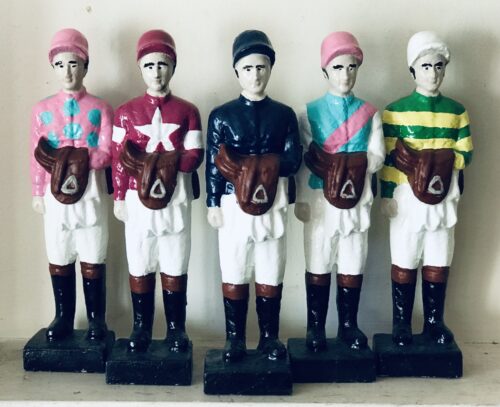
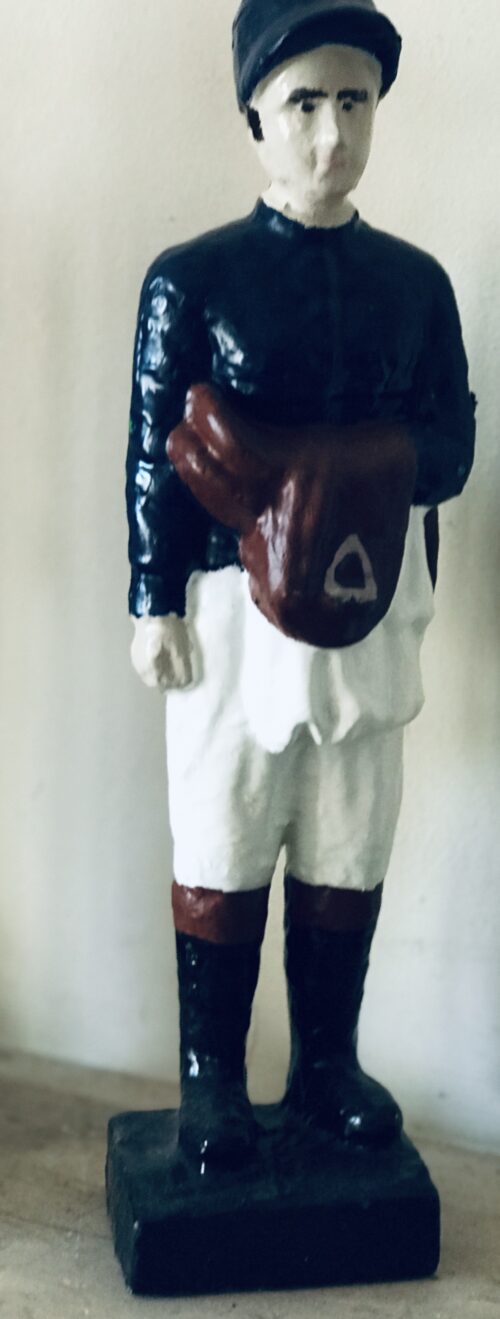 Unique and unusual cast-iron Jockey Figurine in the legendary Coolmore colours (Mrs John Magnier.This charming little gentleman stands 38cm tall and is approx 10cm wide at his plinth.They weigh a surprising 6kg.These limited edition figurines were part of a collection which stood pride of place at a well known public house in Co Kerry.Also available in colours such as Rich Ricci,Gigginstown,Coolmore,JP McManus.These figurines will make a stunning addition to any home bar or pub. 38cm x 10cm 6kg
Unique and unusual cast-iron Jockey Figurine in the legendary Coolmore colours (Mrs John Magnier.This charming little gentleman stands 38cm tall and is approx 10cm wide at his plinth.They weigh a surprising 6kg.These limited edition figurines were part of a collection which stood pride of place at a well known public house in Co Kerry.Also available in colours such as Rich Ricci,Gigginstown,Coolmore,JP McManus.These figurines will make a stunning addition to any home bar or pub. 38cm x 10cm 6kg -
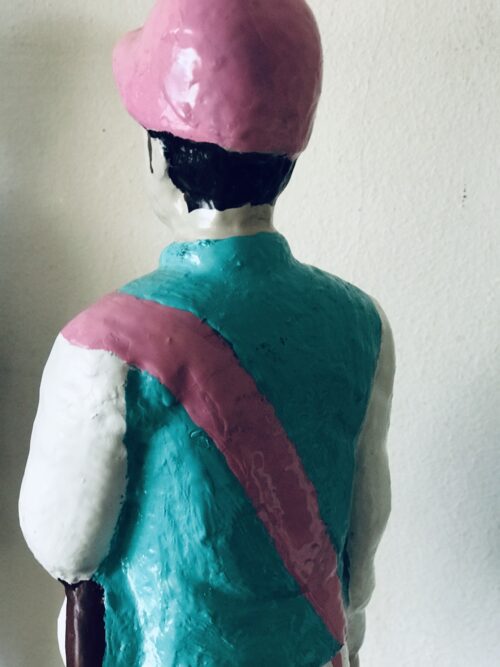
 Unique and unusual cast-iron Jockey Figurine in the legendary Frankel colours (Khalid Abdulla-Juddmonte ).This charming little gentleman stands 38cm tall and is approx 10cm wide at his plinth.They weigh a surprising kg.These limited edition figurines were part of a collection which stood pride of place at a well known public house in Co Kerry.Also available in colours such as Rich Ricci,Gigginstown,Coolmore,JP McManus.These figurines will make a stunning addition to any home bar or pub. 38cm x 10cm 5kg
Unique and unusual cast-iron Jockey Figurine in the legendary Frankel colours (Khalid Abdulla-Juddmonte ).This charming little gentleman stands 38cm tall and is approx 10cm wide at his plinth.They weigh a surprising kg.These limited edition figurines were part of a collection which stood pride of place at a well known public house in Co Kerry.Also available in colours such as Rich Ricci,Gigginstown,Coolmore,JP McManus.These figurines will make a stunning addition to any home bar or pub. 38cm x 10cm 5kg -

 Unique and unusual cast-iron Jockey Figurine in Gigginstown colours.This charming little gentleman stands 38cm tall and is approx 10cm wide at his plinth.They weigh a surprising 6kg.These limited edition figurines were part of a collection which stood pride of place at a well known public house in Co Kerry.Also available in colours such as Rich Ricci,Gigginstown,Coolmore,JP McManus.These figurines will make a stunning addition to any home bar or pub. 38cm x 10cm 6kg
Unique and unusual cast-iron Jockey Figurine in Gigginstown colours.This charming little gentleman stands 38cm tall and is approx 10cm wide at his plinth.They weigh a surprising 6kg.These limited edition figurines were part of a collection which stood pride of place at a well known public house in Co Kerry.Also available in colours such as Rich Ricci,Gigginstown,Coolmore,JP McManus.These figurines will make a stunning addition to any home bar or pub. 38cm x 10cm 6kg -
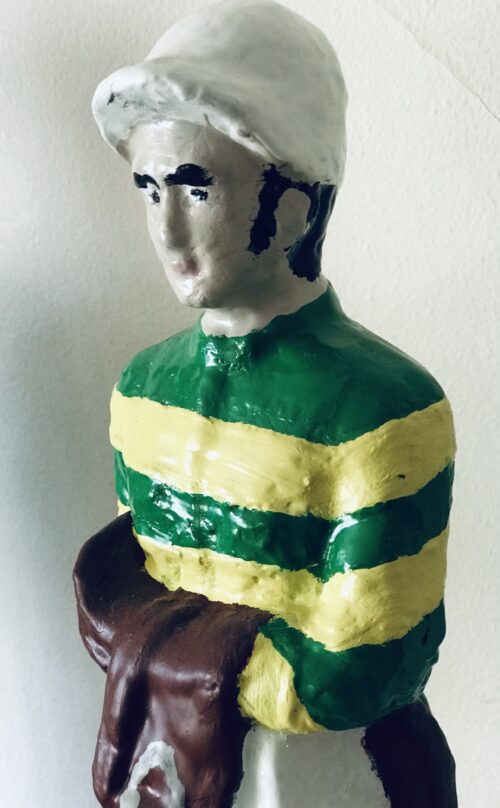
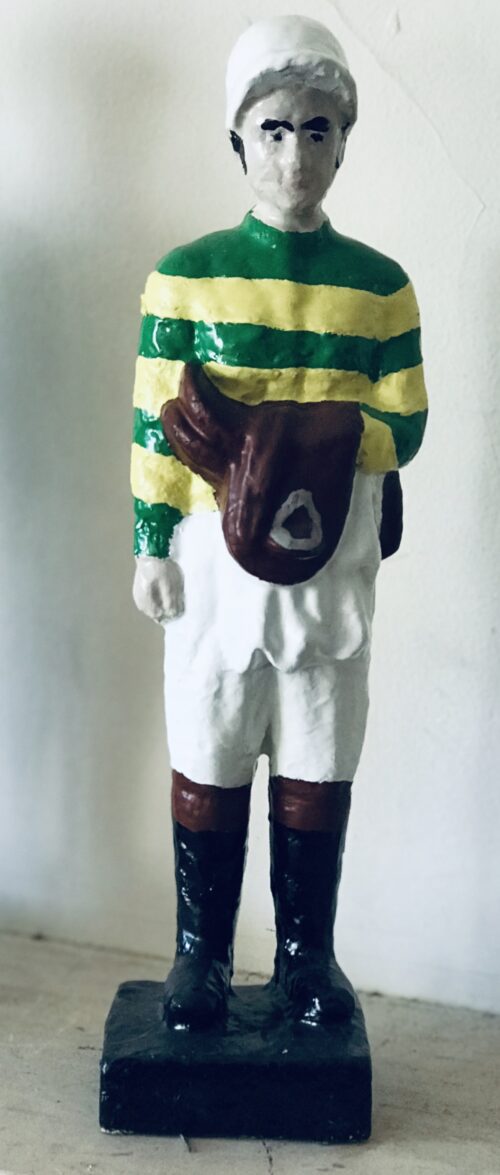 Unique and unusual cast-iron Jockey Figurine in the legendary JP McManus These charming little gentleman stands 38cm tall and is approx 10cm wide at his plinth.They weigh a surprising 6kg.These limited edition figurines were part of a collection which stood pride of place at a well known public house in Co Kerry.Also available in colours such as Rich Ricci,Gigginstown,Coolmore,Arkle,Frankel.These figurines will make a stunning addition to any home bar or pub. 38cm x 10cm 6kg
Unique and unusual cast-iron Jockey Figurine in the legendary JP McManus These charming little gentleman stands 38cm tall and is approx 10cm wide at his plinth.They weigh a surprising 6kg.These limited edition figurines were part of a collection which stood pride of place at a well known public house in Co Kerry.Also available in colours such as Rich Ricci,Gigginstown,Coolmore,Arkle,Frankel.These figurines will make a stunning addition to any home bar or pub. 38cm x 10cm 6kg -

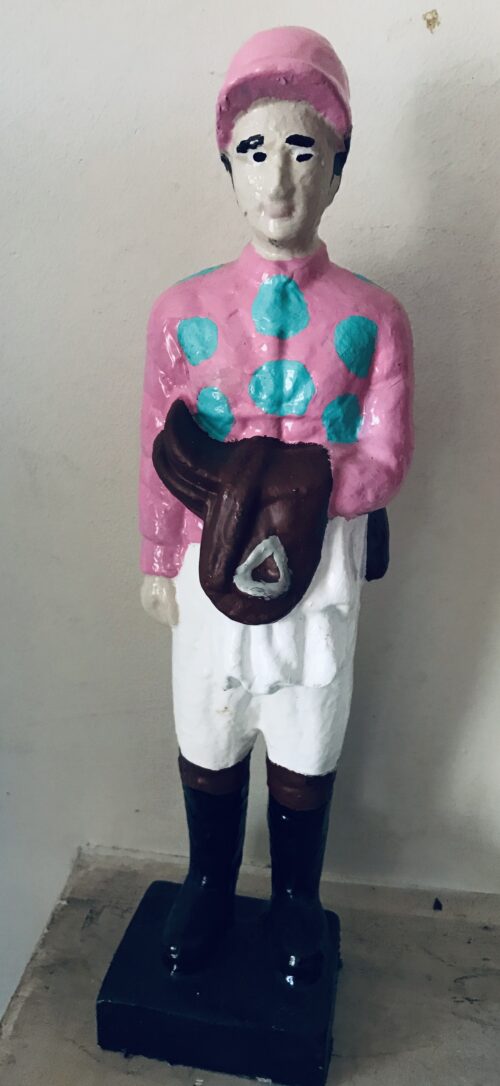 Unique and unusual cast-iron Jockey Figurine in the legendary Rich Ricci colours.This charming little gentleman stands 38cm tall and is approx 10cm wide at his plinth.They weigh a surprising kg.These limited edition figurines were part of a collection which stood pride of place at a well known public house in Co Kerry.Also available in colours such as Rich Ricci,Gigginstown,Coolmore,JP McManus.These figurines will make a stunning addition to any home bar or pub. 38cm x 10cm 5kg
Unique and unusual cast-iron Jockey Figurine in the legendary Rich Ricci colours.This charming little gentleman stands 38cm tall and is approx 10cm wide at his plinth.They weigh a surprising kg.These limited edition figurines were part of a collection which stood pride of place at a well known public house in Co Kerry.Also available in colours such as Rich Ricci,Gigginstown,Coolmore,JP McManus.These figurines will make a stunning addition to any home bar or pub. 38cm x 10cm 5kg -

 65cm x 50cm PHOTOGRAPHER TARQUIN BLAKE has a penchant for visiting parts of Ireland people don’t always get to see. He’s written about and photographed Ireland’s abandoned ‘big houses’ and haunted houses, but for his latest book he turns his sights on Irish castles. Like his previous books, Exploring Irish Castles is a coffee table book filled with gorgeous photos and the background stories to some fascinating locations. While his previous book ideas came from his own travels throughout Ireland, this topic was suggested by his publisher – showing how popular Irish castles are to the Irish and those abroad. “I was given an objective – the book had to cover all the main Irish castles and it should cover a variety of ruins, family homes and heritage sites that are open to the public,” explains Blake. “I went off and started investigating all the Irish castles, drawing up a list of the best ones. I started going out visiting them – I visited about 100 castles and 40 of those ended up in the book.” He wanted to cover all the main periods of Irish castles, from the big Anglo Norman castles like Trim Castle to the tower houses and fortified houses, which are the commonest small castle in Ireland. The book also has a selection of the neo gothic castles – the Victorian country houses made to look like castles. Blake did a lot of in-depth research into the castles for the book. “What I found was a lot of the tower houses would have very little history so they weren’t very suitable for including in the book,” he says. There are around 6,000 towers in Ireland, but Blake says that there are very few records related to them around. He gave some insight into the history of castles here: “The concept of using building methods to protect territory was introduced from overseas in the 12th century, when the Irish term caisleán began to appear in manuscripts. By the 16th century, Ireland had become the most castellated country in Europe.” “The tower houses were built up until the early 1600s and it’s generally recognised that Cromwell’s invasion put an end to true castle building,” says Blake. This is because after the invention of artillery, the castle didn’t provide enough protection from invaders. “Before that they were pretty much invincible and everybody was building them and everyone was living in them,” he says. “After Cromwell, they went back to the renaissance houses, and the big country houses in the Georgian period.” The book features very well-known castles, such as Trim Castle and Blarney Castle, but also some lesser-known locations, such as Co Galway’s Fiddaun Castle. It’s all about trying to encourage people to visit the spots, says Blake. One of the most interesting locations was Tullynally Castle in Co Westmeath. Thomas Packenham, the historian, and his family still live there. “It was a fascinating place to visit,” says Blake. “It’s pretty impressive – it is the largest family home in Ireland.”For me the most interesting part was visiting the places and meeting the people. It was great seeing Tullynally, that’s an example there of seeing how people still live in these places. They have massive kitchen and the huge halls, and you can’t really imagine the rooms – big enough to fit 200-300 people.
65cm x 50cm PHOTOGRAPHER TARQUIN BLAKE has a penchant for visiting parts of Ireland people don’t always get to see. He’s written about and photographed Ireland’s abandoned ‘big houses’ and haunted houses, but for his latest book he turns his sights on Irish castles. Like his previous books, Exploring Irish Castles is a coffee table book filled with gorgeous photos and the background stories to some fascinating locations. While his previous book ideas came from his own travels throughout Ireland, this topic was suggested by his publisher – showing how popular Irish castles are to the Irish and those abroad. “I was given an objective – the book had to cover all the main Irish castles and it should cover a variety of ruins, family homes and heritage sites that are open to the public,” explains Blake. “I went off and started investigating all the Irish castles, drawing up a list of the best ones. I started going out visiting them – I visited about 100 castles and 40 of those ended up in the book.” He wanted to cover all the main periods of Irish castles, from the big Anglo Norman castles like Trim Castle to the tower houses and fortified houses, which are the commonest small castle in Ireland. The book also has a selection of the neo gothic castles – the Victorian country houses made to look like castles. Blake did a lot of in-depth research into the castles for the book. “What I found was a lot of the tower houses would have very little history so they weren’t very suitable for including in the book,” he says. There are around 6,000 towers in Ireland, but Blake says that there are very few records related to them around. He gave some insight into the history of castles here: “The concept of using building methods to protect territory was introduced from overseas in the 12th century, when the Irish term caisleán began to appear in manuscripts. By the 16th century, Ireland had become the most castellated country in Europe.” “The tower houses were built up until the early 1600s and it’s generally recognised that Cromwell’s invasion put an end to true castle building,” says Blake. This is because after the invention of artillery, the castle didn’t provide enough protection from invaders. “Before that they were pretty much invincible and everybody was building them and everyone was living in them,” he says. “After Cromwell, they went back to the renaissance houses, and the big country houses in the Georgian period.” The book features very well-known castles, such as Trim Castle and Blarney Castle, but also some lesser-known locations, such as Co Galway’s Fiddaun Castle. It’s all about trying to encourage people to visit the spots, says Blake. One of the most interesting locations was Tullynally Castle in Co Westmeath. Thomas Packenham, the historian, and his family still live there. “It was a fascinating place to visit,” says Blake. “It’s pretty impressive – it is the largest family home in Ireland.”For me the most interesting part was visiting the places and meeting the people. It was great seeing Tullynally, that’s an example there of seeing how people still live in these places. They have massive kitchen and the huge halls, and you can’t really imagine the rooms – big enough to fit 200-300 people.Castle facts
Kilwaughter Castle, County Antrim- There are quite a number of Patrick Agnews in the family, resulting in a bit of a genealogical headache.
- It was used to billet Americans from the 644th Tank Destroyer Battalion in preparation for D-Day.
- It occupies a wild position perched on top of the cliff. In 1639 a section of the kitchen collapsed when the cliff face underneath gave way. The dinner, kitchen tables, and all the silverware fell into the sea below.
- Nine of the kitchen staff fell to their deaths and the kitchen boy only survived by clinging to a corner of the crumbling wall.
- After his father’s death in 1581, David Barry, fifth Viscount Buttevant, set fire to the castle, rendering it unliveable so that Sir Walter Raleigh couldn’t have it.
- In 1751, Richard Barry became the sixth earl when he was six years old. A reckless gambler and drinker, he served briefly in the 9th Regiment of Dragoons before dying of a fever at the age of 28.
- In 1599, four-year-old Elizabeth, Queen Elizabeth’s namesake and godchild, inherited the Mallow property. The story goes that the Queen sent her godchild two white deer as a christening gift, and the herd of white deer at Mallow today is descended from this original pair.
- In the eighteenth century, Mallow Castle became fantastically famous for its social goings-on, becoming known as ‘The Bath of Ireland’.
- Sir John Jephson upheld a bizarre ritual of having a white rat on a small chair at his right-hand side during all meals, believing this would keep him free from debt. Apparently, the white rat then often appeared before the head of the Jephson family, predicting their imminent demise.
- The hill upon which it is built is a long extinct volcano.
- ‘Fighting Charlie’ was a mean landlord – he gave just £30 for famine relief but spent £15,000 renovating his home.
- You can see the Isle of Man and Scotland from the tower on a clear day.
- The third Earl of Rosse built the 16-ton telescope called Leviathan, which remained the world’s largest telescope until 1917.
- His wife, Lady Mary, was an accomplished early pioneer of photography and installed a darkroom. It is the oldest surviving example of its kind in the world.
- Their son Charles invented the steam turbine. His company eventually became part of Rolls-Royce and still survives as a division of Siemens.
- Jonathan Charles Darby found three upright skeletons sealed into a wall and bricked them up again because he decided there must have been a good reason to put them there.
- It has a reputation as the most haunted castle in Europe.









